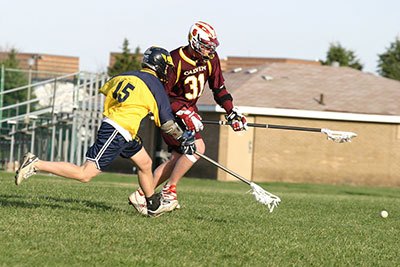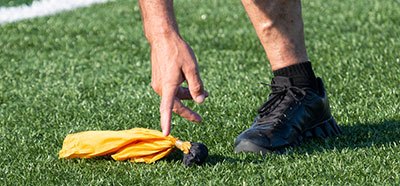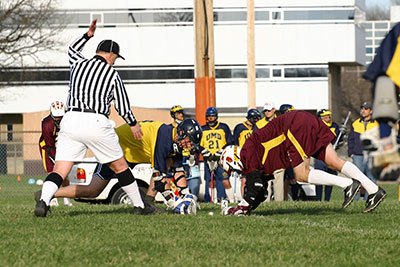Are you a lacrosse player looking to take your game to the next level? Have you been getting called for illegal screens but aren't sure why?
Here's some helpful information and advice on how to understand and avoid violations of the lacrosse illegal screen penalty in this exciting sport.
With key insights about what is recognized as an illegal screen and tips on staying within league rules and regulations, learning about this issue can be easy and fun!
More...
Take away key points:
For those unsure about the lacrosse illegal screen penalty and what to know more, please refer to the guide below to learn all crucial factors regarding the violation of the committed penalty.
What is a lacrosse illegal screen penalty?
Defending against offensive players trying to score a goal in lacrosse is a key factor in saving your team trouble. Lacrosse rules allow the defense to protect their side of the field against the offensive players.
However, the action must be done without any active impediment from the offending team. But, if an offensive player deliberately tries to disrupt a defender's block, the offensive player will be called for an illegal screen penalty.

When is screening legal in lacrosse?
The legal lacrosse screen requires the offense to remain vertical in their position, with their feet and shoulder width the same. The player cannot move their hips or shoulder into the defender's path as part of the screening, even if the legs of the opponent remain stationary.
In addition, the screen must occur within five yards of the loose ball to be legal. If the defender and opponent make contact to delay each other, the screen will be illegal during the play.
When is screen illegal?
The lacrosse rules state that it is illegal for any offensive player to hold their lacrosse stick outward, rigidly to impede the defender's movements.
Any contact between the offense without the possession of the ball and the defense must occur when the offense is stationary. Any contact with the defense will be considered an illegal screen penalty.
How can a player commit an illegal screen penalty?
An illegal screen penalty will occur each time the offending player makes contact with the defensive player of the opposing team to block the defenseman from guarding the opposing player with possession of the ball. Offensive players refer to screens to clear paths for their teammates to score goals, but lacrosse rules prohibit screens in a stationary position.
When a defensive player tries to guard one player against the other team, and the offender runs towards them to block their actions from stopping the player with possession of the ball, the offender is committing the illegal screen penalty.
Are illegal screen penalties technical fouls or personal fouls?
The offensive player committing illegal screen penalties will commit technical fouls. Technical fouls are not as severe as personal fouls and are considered minor infractions.
However, if the offensive player commits five technical fouls, the officials may eject him from the field and further play.
Examples of the illegal screening
Below are some of the most common examples of illegal screening for a better understanding:
- A player holds his downward position and holds the stick in front, with the head turned down. Another player from his team has possession of the ball and cuts him while an opponent pursues him. The opponent then falls over the first player's stick as an illegal screen. As a result, the first player is called for a penalty by referees.
- A player heads down the field with the ball toward his team member in team A. The second player extends his hands and stick, and the first player moves around him. An opposing defender, the third player from team B runs towards the extended cross, and the second player holds him back. The second player will receive a technical foul as a player making a trespass in illegal screening.
- The first player observes his team member - the defender chases the second player from the other team. The first player moves away from the defender, but he impedes him from pursuing the second player and makes contact with the defender. As a result, the first player will receive a technical foul for illegal screening, even though he was moving away from the opponent. This is because he made contact while moving.
When will a referee call for an illegal screen penalty?

When a referee notices the illegal screen in youth lacrosse and NCAA men's lacrosse, he will toss a yellow flag on the ground, considering the screen a technical foul. The referee will change the possession of the ball to the opponent.
Since the screen can happen only on the offensive side of the field, the penalty won't include any one-to-three minutes of serving penalty time in the penalty box, but only the change of the possession of the ball to the opponent.
How can a referee signal the illegal screen?
The signal for the younger players and NCAA men's lacrosse is the same.
First, the referee will bend the elbow of his left arm and clench the fist to be near their chin. Then, the referee makes a fist in the right arm, bends the right elbow, and makes the punching motion into the raised left arm.
What happens if the opposing team scores during an illegal screen?
If an illegal screen occurs during a lacrosse game, and the opponent scores while the screen is in action, the goal will be nullified.
The player that committed the illegal screen will then receive a penalty, and the possession of the ball is given to the opponent. A warning may also be given to the offending player or team if deemed appropriate or necessary.
Penalties similar to illegal screen penalties

There are multiple penalty types similar to the illegal screening in lacrosse. Some of them include: pushing, warding, holding, interference, illegal touching of the ball, illegal procedure.
Pushing
Pushing in lacrosse is when a player shoves or thrusts the opponent from behind.
Warding
Warding in lacrosse represents the act of pushing another player with your arms while in possession of the ball.
Holding
Holding in lacrosse is the act of one player keeping another player from getting to where he is going by using their feet, stick, or arms.
Interference
Interference is an act in which a player impedes the movement of another player who is not in possession of the ball or is further than five yards away from a flying ball or a loose ball. Any player, including a goalie, can commit interference.
Illegal touching of the ball
Illegal touching of the ball is an act of touching the ball with hands instead of using the stick.
Illegal procedure
The illegal procedure includes various technical fouls, touching the ball, including failure to advance, too many players on the field, delaying the game, entering the game before the entire penalty time has passed, etc.
More serious violations, such as unsportsmanlike conduct, illegal body checking, unnecessary roughness, etc., result in personal fouls, and the team must play without a player.
FAQs
Can you run through a screen in lacrosse?
No, you cannot run through a screen in lacrosse. Running through a screen is illegal in lacrosse as it aims to reduce physical contact and decrease the risks of playing the game, such as injury. If an official sees this form of play, a penalty will be issued against the offending party.
Are picks or screens allowed in lacrosse?
Players are allowed to set a screen or pick; however, they must set themselves within the visible line of their opponent. The opponents can change their direction.
Conclusion
In short, a lacrosse illegal screen penalty is not classified as a personal foul. This means that the play cannot cause an injury to another player. However, the offender will still be penalized according to the game's rules.
